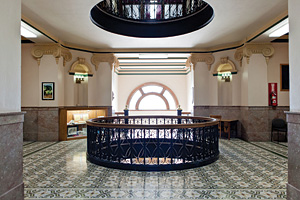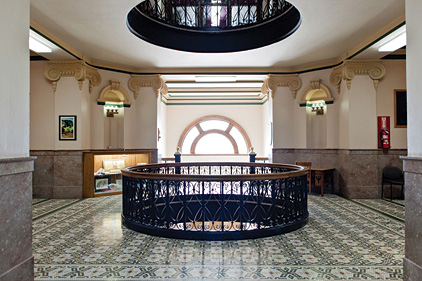The allure of energy efficiency across multiple HVACR sectors is aiding in the rise of contractor interest in variable-refrigerant flow (VRF) technology. In fact, one contractor noted in a brief interview that he, “Wished the magazine wasn’t giving away one of the best kept secrets of HVAC by telling everyone about VRF systems.”
The Many Faces of VRF
Even with the cat out of the bag, there are more VRF applications to discover. Take, for instance, the combination of VRF with renewable-energy concepts or geothermal equipment. That is what one contractor did on a 1907 courthouse located in Muscatine, Iowa.

|
| The pairing of geothermal and other HVAC technologies with VRF is producing different energy-efficient and renewable solutions for contractors. |
The Muscatine County Courthouse was in need of an HVAC system replacement, and the Muscatine County board of supervisors sent out a request for proposal (RFP) to local firms. One of those who answered was A&J Associates, PC, North Liberty, Iowa. Vic Amoroso, the mechanical engineering firm’s president, boasts 40 years of HVAC design engineering experience. He presented before the board in response to the RFP on behalf of the company.
“Conscious of safeguarding taxpayer dollars, county governments are not known for being on the cutting edge of technology, but the board wanted to learn more about the green initiative,” said Sherry Seright, budget director for Muscatine County. She remembered how impressed the board was with Amoroso’s presentation. “He was no-nonsense, honest, and demonstrated to the board they were on the right track. He showed the board the basics of a closed-loop geothermal system and how smoothly it would work in tandem with a VRF zoning system.”
According to Seright, Amoroso proved to the board that this solution would be less expensive than replacing the building’s current system with new boilers and chillers.
“We are a small engineering firm and questioning traditional design is the reason we have been successful over the years,” said Amoroso. “We prefer unusual projects not being as widely designed, like geothermal and VRF.”
Together with Climate River Valley (now recognized as Climate Engineers), an HVAC contractor in Eldridge, Iowa, Amoroso had a VRF zoning system installed. According to him, it was because its engineering design would overcome the installation challenges posed by the 106-year-old building with its 24-inch-thick limestone walls. The VRF zoning system efficiencies coupled with the heat sync exchange of the campus geothermal field could serve both the courthouse and the new jail addition across the street. The geothermal campus was a hybrid, closed-loop system with 60 vertical and 40 horizontal wells.
“We sized the geothermal loop field to handle 450 gallons per minute (gpm) flow at the design heating and cooling load,” noted Amoroso. “The geothermal pumps are variable speed and adjust to what is needed in the overall campus balance.”
Due to the system’s success, the Muscatine County board decided that when other county systems are in need of being replaced, the partnership of geothermal and Mitsubishi Electric VRF zoning systems would be the new standard.
“We are all thrilled with the performance of this technology partnership,” said Seright. “As budget director, I can tell you the clearest proof of the success of our decision came when the 30,000-square-foot jail addition was tied in to the campus geothermal field between both buildings. The energy bill did not move up one tick. That’s amazing proof of how this technology works.”
Interconnecting VRF and Industry Technology
According to officials at Fujitsu General America Inc. in Fairfield, N.J., other applications of VRF technology are trending toward mainstream as contractors continue to interconnect VRF and conventional technology.
“The building owner is going to continue to seek energy-efficient solutions for his HVAC system’s needs,” said Reid Goyert, Midwest regional sales engineer, Fujitsu General America Inc. “Mini-split and VRF technology is going to respond by raising the bar on energy consumption. Controls, such as motion sensors and interconnection with conventional equipment, will blend mini-splits and VRF with other efficient systems to create a hybrid system.”
Goyert noted that one of these interconnections is the dc inverter-driven heat pump and VRF.
“The dc inverter-driven compressor heat pump is the core of the mini-split and VRF ducted and ductless equipment market,” he explained. “As an HVAC manufacturer, 100 percent of Fujitsu’s products are dc inverter-driven heat pumps.”
Fujitsu considers the heat recovery system a further extension of the inverter-driven VRF heat pump.
“This type of VRF allows a building to use or recover the Btu generated from internal loads within a building and transfer them from those zones being cooled to those zones needing heating,” said Goyert. “If a building is in a state of equilibrium, the coefficient of performance doubles.”
The company expects that the introduction of heat recovery VRF systems in North America will become a product category that commercial renewable-market contractors and designers will see as more of the norm and not the exception in the not-too-distant future.
Publication date: 11/25/2013
Want more HVAC industry news and information? Join The NEWS on Facebook, Twitter, and LinkedIn today!


Report Abusive Comment